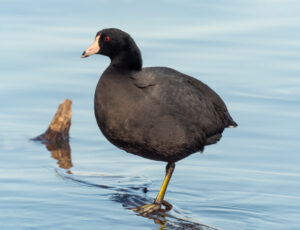
For most bird watchers, the best time to see a Barrow’s Goldeneye, Bucephala islandica, is during the winter and the best place is a northern cove or inlet where fresh water flows into the ocean. This cold water duck spends its winters diving for mussels and other mollusks near the coast where water doesn’t freeze.
Identify Barrow’s Goldeneye
The male duck in black and white breeding plumage is easily recognized by key features:
- Striking yellow eyes
- Crescent-shaped white patches in front of the eyes
- A steep forehead
- A band of black separating the white of chest and sides
The male’s head appears black but actually has a purplish-blue sheen when viewed close up. The more numerous Common Goldeneye looks very similar, but the white patch in front of the eye is circular, the forehead slopes more gradually, and the black band on the sides is lacking. Both species produce a distinct whistling sound in flight.
A female Barrow’s Goldeneye is less distinctive, but she is usually the bird swimming close to the male – grayish brown, she has a yellow bill in breeding season.
Barrow’s Goldeneye Range
The Barrow’s Goldeneye is native to northeastern and northwestern North America and Iceland. Some birds winter inland in open water in the American Midwest, and individuals sometimes stray into Europe, but most winter in coastal British Columbia, Alaska, and in the East from the southern Gulf of St. Lawrence to Cape Cod. They stay close to shore where mussels grow, and prefer brackish (slightly salty) water.
This species is harder to find in summer when it breeds near high altitude lakes and ponds, typically in mature forest. The Barrow’s Goldeneye breeds in British Columbia, the Yukon, Alaska, and Eastern Quebec.
Barrow’s Goldeneye Breeding and Nesting
This is a cavity nesting duck that doesn’t excavate its own nest hole; therefore, it relies on a mature forest ecosystem where there are old dead and dying trees and healthy woodpecker populations. The birds sometimes also nest in rock crevices, in burrows, or under dead wood on the forest floor. The female lines the nest with feathers and usually lays 10 – 12 eggs.
Eggs hatch in about a month and the downy chicks leave the nest after only two or three days, but remain with the adult female for about two months. Some females lay eggs in the nests of others, and chicks of one brood may join another and be cared for by a female who is not their mother. During the breeding season, the birds eat aquatic insects and plant seeds, as well as fresh water mollusks and crustaceans.
Threats to Barrow’s Goldeneye
Though populations in Eastern Canada and Iceland are small and therefore vulnerable, the species is not threatened overall. Oil spills that fowl ocean coastlines during the winter months, and logging and development in the summer range can all impact the species.
